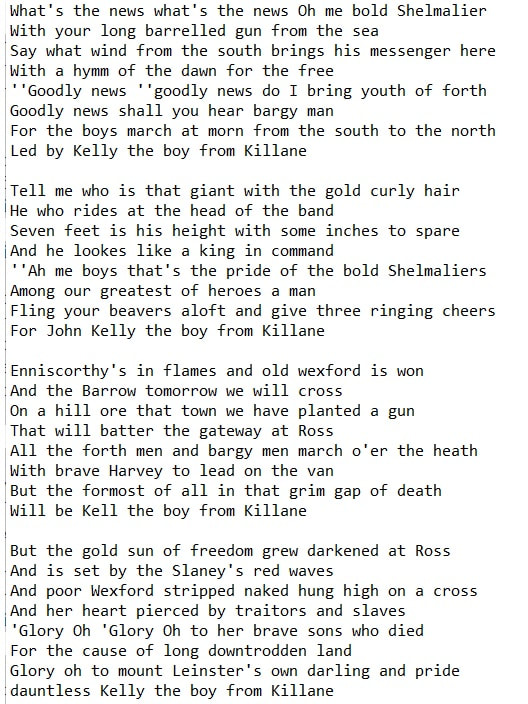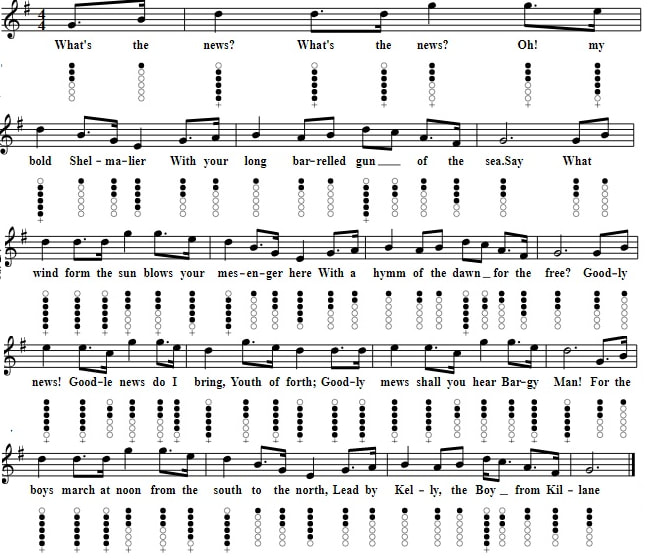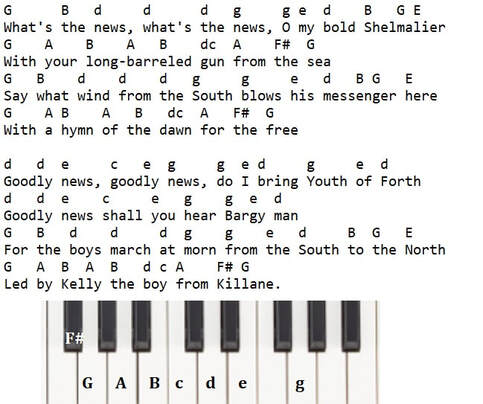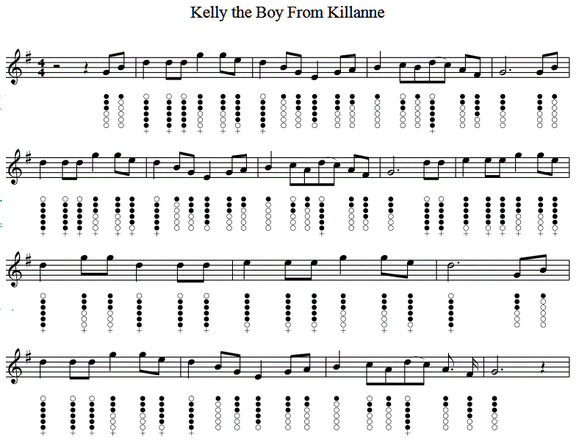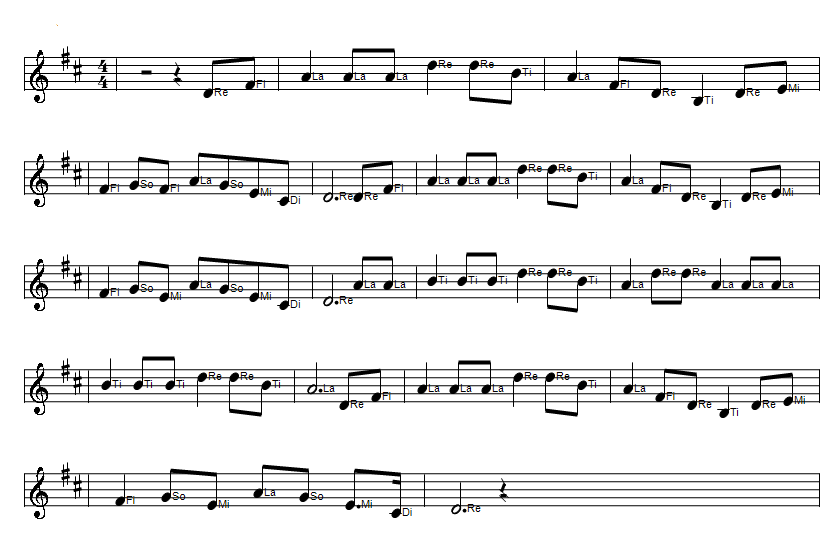Kelly From Killane Irish Song Lyrics And Chords
Tin Whistle And Sheet Music Notes included. The song was written by P.J. Mc Call. The song is about John Kelly who was captured after being wounded in Wexford town, he was hanged at Wexford bridge and then be-headed and his body thrown into the river-his head was kicked along the street before being piked-the local people later recovered his body and gave him a Christian burial-later a monument was placed at the scene. This old ballad was also recorded by The High Kings, The Clancy Brothers and Tommy Makem and Dubliner Damien Dempsey. [ An Irish folk / rebel song ] The most famous recording was done for German T.V. and it's the youtube video below with Luke Kelly doing the singing with The Dubliners [ lyrics ]. Kelly the boy from Killane beginner piano notes included. The guitar chords in chordpro are in C, G, and E which is the key Luke Kelly is singing in.Kelly the boy from Killane sheet music notes in solfege , [ Do re mi format ] now included plus a pdf file for downloading.
What's[C] the news what's the[Am] news Oh me[C] bold Shelma[F]lier
With your[C] long barrelled[G7] gun from the[C] sea
Say what wind from the[Am] south brings his[C] messenger[F] here
With a[C] hymm of the[G7] dawn for the[C] free
''Goodly[F] news ''goodly news do I[C] bring youth of forth
Goodly[F] news shall you hear bargy[G7] man
For the[C] boys march at[Am] morn from the[C] south to the[F] north
Led by[C] Kelly the[G7] boy from[C] Killane
Tell me who is that giant with the gold curly hair
He who rides at the head of the band
Seven feet is his height with some inches to spare
And he lookes like a king in command
''Ah me boys that's the pride of the bold Shelmaliers
Among our greatest of heroes a man
Fling your beavers aloft and give three ringing cheers
For John Kelly the boy from Killane
Enniscorthy's in flames and old wexford is won
And the Barrow tomorrow we will cross
On a hill ore that town we have planted a gun
That will batter the gateway at Ross
All the forth men and bargy men march o'er the heath
With brave Harvey to lead on the van
But the formost of all in that grim gap of death
Will be Kell the boy from Killane
But the gold sun of freedom grew darkened at Ross
And is set by the Slaney's red waves
And poor Wexford stripped naked hung high on a cross
And her heart pierced by traitors and slaves
'Glory Oh 'Glory Oh to her brave sons who died
For the cause of long downtrodden land
Glory oh to mount Leinster's own darling and pride dauntless Kelly the boy from Killane
With your[C] long barrelled[G7] gun from the[C] sea
Say what wind from the[Am] south brings his[C] messenger[F] here
With a[C] hymm of the[G7] dawn for the[C] free
''Goodly[F] news ''goodly news do I[C] bring youth of forth
Goodly[F] news shall you hear bargy[G7] man
For the[C] boys march at[Am] morn from the[C] south to the[F] north
Led by[C] Kelly the[G7] boy from[C] Killane
Tell me who is that giant with the gold curly hair
He who rides at the head of the band
Seven feet is his height with some inches to spare
And he lookes like a king in command
''Ah me boys that's the pride of the bold Shelmaliers
Among our greatest of heroes a man
Fling your beavers aloft and give three ringing cheers
For John Kelly the boy from Killane
Enniscorthy's in flames and old wexford is won
And the Barrow tomorrow we will cross
On a hill ore that town we have planted a gun
That will batter the gateway at Ross
All the forth men and bargy men march o'er the heath
With brave Harvey to lead on the van
But the formost of all in that grim gap of death
Will be Kell the boy from Killane
But the gold sun of freedom grew darkened at Ross
And is set by the Slaney's red waves
And poor Wexford stripped naked hung high on a cross
And her heart pierced by traitors and slaves
'Glory Oh 'Glory Oh to her brave sons who died
For the cause of long downtrodden land
Glory oh to mount Leinster's own darling and pride dauntless Kelly the boy from Killane
Chords in the key of G Major.
What's[G] the news what's the[Em] news Oh me[G] bold Shelma[C]lier
With your[G] long barrelled[D7] gun from the[G] sea
Say what wind from the[Em] south brings his[G] messenger[C] here
With a[G] hymn of the[D7] dawn for the[G] free
''Goodly[C] news ''goodly news do I[G] bring youth of forth
Goodly[C] news shall you hear bargy[D7] man
For the[G] boys march at[Em] morn from the[G] south to the[C] north
Led by[G] Kelly the[D7] boy from[G] Killane
What's[G] the news what's the[Em] news Oh me[G] bold Shelma[C]lier
With your[G] long barrelled[D7] gun from the[G] sea
Say what wind from the[Em] south brings his[G] messenger[C] here
With a[G] hymn of the[D7] dawn for the[G] free
''Goodly[C] news ''goodly news do I[G] bring youth of forth
Goodly[C] news shall you hear bargy[D7] man
For the[G] boys march at[Em] morn from the[G] south to the[C] north
Led by[G] Kelly the[D7] boy from[G] Killane
The Luke Kelly and The Dubliners version of the guitar chords
[E]What's the news [A]what's the news Oh me bold Shelma[E]lier
With your long barrelled[B] gun from the[E] sea
Say what wind from the south brings his messenger here
With a hymm of the[B] dawn for the[E] free
''Goodly[A] news ''goodly news do I[E] bring youth of forth
Goodly[A] news shall you hear bargy[B] man
For the[E] boys march at morn from the south to the north
Led by Kelly the[B] boy from Kill[E]ane
[E]What's the news [A]what's the news Oh me bold Shelma[E]lier
With your long barrelled[B] gun from the[E] sea
Say what wind from the south brings his messenger here
With a hymm of the[B] dawn for the[E] free
''Goodly[A] news ''goodly news do I[E] bring youth of forth
Goodly[A] news shall you hear bargy[B] man
For the[E] boys march at morn from the south to the north
Led by Kelly the[B] boy from Kill[E]ane
Below is the list of sheet music and tin whistle songs that are in my ebooks. This is the largest collection of tin whistle songs ever put together.[over 800 songs ] Including folk, pop and trad tunes plus German And French songs along with Christmas Carols.
All of the sheet music tabs have been made as easy to play as was possible.
The price of the ebooks is €7.50
All of the sheet music tabs have been made as easy to play as was possible.
The price of the ebooks is €7.50
The Irish ballad 'Kelly From Killane' is a powerful representation of Irish history, culture, and national identity. The song tells the story of John Kelly, a leader of the Irish Rebellion of 1798, and his ultimate sacrifice for his country and people. Through its lyrics and melody, 'Kelly From Killane' captures the struggles, bravery, and resilience of the Irish people in their fight for independence.
The origins of 'Kelly From Killane' can be traced back to the 19th century, during a time of great political and social upheaval in Ireland. The country was under British rule, and the Irish people were subjected to discrimination, poverty, and oppression. In response, many rebellions and uprisings took place, with the most notable being the Irish Rebellion of 1798.
The rebellion was led by a group of Irish nationalists, including John Kelly, who hailed from the small village of Killane in County Wexford. Kelly was known for his bravery, leadership, and unwavering commitment to the cause of Irish independence. He and his followers fought against the British forces, but ultimately, they were outnumbered and outgunned. The rebellion was brutally suppressed, and many of its leaders, including Kelly, were executed.
It was in the aftermath of the rebellion that 'Kelly From Killane' emerged as a popular folk song. The lyrics were written by Patrick Joseph McCall, an Irish nationalist and songwriter, and the melody was adapted from an old Irish tune. The song quickly gained popularity among the Irish people, who saw it as a symbol of their struggle and a tribute to the heroes of the rebellion.
The melody of 'Kelly From Killane' is equally stirring and adds to the emotional impact of the song. The tune is upbeat and lively, evoking a sense of pride and determination. At the same time, it has a haunting quality that reflects the tragedy and loss of the rebellion. The combination of the powerful lyrics and the memorable melody makes 'Kelly From Killane' an enduring and beloved part of Irish culture.
The song's popularity has endured through the centuries, and it has been recorded by numerous artists, both in Ireland and abroad. Its enduring appeal lies in its ability to connect with people on a deep emotional level. It speaks to the struggles and sacrifices of the Irish people and serves as a reminder of their ongoing fight for independence.
In addition to its cultural significance, 'Kelly From Killane' also holds historical value. The song provides a glimpse into the events of the Irish Rebellion of 1798 and the lives of its leaders, including John Kelly. It serves as a testament to their bravery and their determination to fight for their country and their people.
In conclusion, 'Kelly From Killane' is more than just a song; it is a powerful representation of Irish history, culture, and national identity. Through its lyrics and melody, it captures the struggles, bravery, and resilience of the Irish people in their fight for independence. Its enduring popularity is a testament to its emotional impact and its ability to connect with people across generations. As long as the Irish people continue to sing 'Kelly From Killane,' the spirit of John Kelly and the rebellion of 1798 will live on.
The origins of 'Kelly From Killane' can be traced back to the 19th century, during a time of great political and social upheaval in Ireland. The country was under British rule, and the Irish people were subjected to discrimination, poverty, and oppression. In response, many rebellions and uprisings took place, with the most notable being the Irish Rebellion of 1798.
The rebellion was led by a group of Irish nationalists, including John Kelly, who hailed from the small village of Killane in County Wexford. Kelly was known for his bravery, leadership, and unwavering commitment to the cause of Irish independence. He and his followers fought against the British forces, but ultimately, they were outnumbered and outgunned. The rebellion was brutally suppressed, and many of its leaders, including Kelly, were executed.
It was in the aftermath of the rebellion that 'Kelly From Killane' emerged as a popular folk song. The lyrics were written by Patrick Joseph McCall, an Irish nationalist and songwriter, and the melody was adapted from an old Irish tune. The song quickly gained popularity among the Irish people, who saw it as a symbol of their struggle and a tribute to the heroes of the rebellion.
The melody of 'Kelly From Killane' is equally stirring and adds to the emotional impact of the song. The tune is upbeat and lively, evoking a sense of pride and determination. At the same time, it has a haunting quality that reflects the tragedy and loss of the rebellion. The combination of the powerful lyrics and the memorable melody makes 'Kelly From Killane' an enduring and beloved part of Irish culture.
The song's popularity has endured through the centuries, and it has been recorded by numerous artists, both in Ireland and abroad. Its enduring appeal lies in its ability to connect with people on a deep emotional level. It speaks to the struggles and sacrifices of the Irish people and serves as a reminder of their ongoing fight for independence.
In addition to its cultural significance, 'Kelly From Killane' also holds historical value. The song provides a glimpse into the events of the Irish Rebellion of 1798 and the lives of its leaders, including John Kelly. It serves as a testament to their bravery and their determination to fight for their country and their people.
In conclusion, 'Kelly From Killane' is more than just a song; it is a powerful representation of Irish history, culture, and national identity. Through its lyrics and melody, it captures the struggles, bravery, and resilience of the Irish people in their fight for independence. Its enduring popularity is a testament to its emotional impact and its ability to connect with people across generations. As long as the Irish people continue to sing 'Kelly From Killane,' the spirit of John Kelly and the rebellion of 1798 will live on.
Kelly the boy from Killane beginner piano notes
Kelly the boy from Killane sheet music notes for the tin whistle
Included below is the pdf version of the sheet music is PDF format in D Major
Kelly the boy from Killane sheet music notes in solfege [ Do re mi format ]
